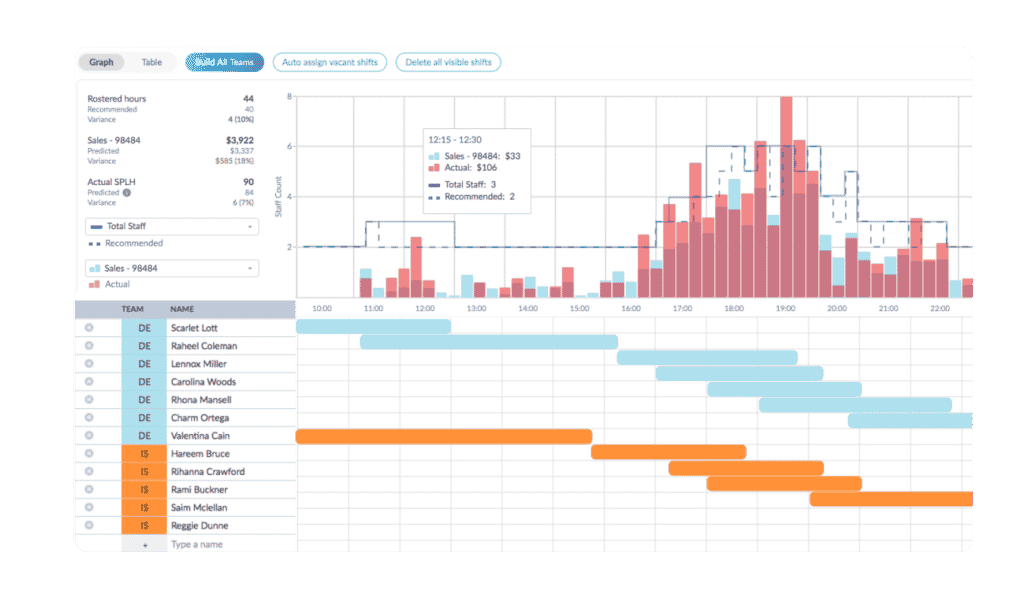Planning work schedules for employees can be a time-consuming process. Planning schedules for hourly workers in Australia can be even more frustrating, like trying to solve a never-ending jigsaw puzzle in which the pieces are constantly changing. It doesn’t have to be so bad. If hourly schedules are the bane of your life, follow these suggestions to make them less of a chore.
What to consider before work schedule planning
As with any complex process, don’t just jump in and start filling in shifts. The more time and energy you devote to preparation, the smoother the end process becomes.
Monitor and map your demand
You’d be shocked how many Australian businesses fail to take into account the basic need to track customer demand when work schedule planning for your hourly employees. Step back and take stock of how your business works on a day-to-day, week-by-week, and month-by-month basis, and let that guide your planning. What are your busiest and quietest periods? Are you in a sector of the Australian market where demand is seasonal? These aren’t questions to be asked once, but something you should query regularly. Patterns change, and it’s all too easy to find yourself overstaffed or understaffed because you didn’t notice in time.
Use past performance to predict your staffing needs
There are several ways you can predict your future staffing requirements based on past performance.
- Staffing Ratio: Looking at your typical staffing ratio can offer a rough guide to working out how many new hires are needed and in which areas. For example, if you generally have 10 workers to every manager, then deviations can tell you if you need more managers, less staff, or some other variation.
- Statistical Regression: For Australian businesses where income is closely tied to staffing, such as call centers, using a statistical regression model allows you to track when your most profitable periods were and see what the staff levels were for those periods, helping you find the most efficient size for your workforce.
- The Delphi Method: For larger companies, this approach involves convening a panel of senior managers and external consultants to pool their insights and offer a roadmap for future staffing needs.
If all of this sounds intimidating, or if you have a new or small business where such data is limited, don’t worry. There are workforce management tools that can automatically provide this analysis for you:

Tanda will automatically generate labor analytics for your business so you can easily identify and deal with inefficiencies
Prepare a clear and concise paid time off policy
You can head off many work schedule planning issues early on by making sure your paid time off (PTO) policy is robust, clear, and up to date. Employees who know what time they are entitled to are empowered to make meaningful decisions about their schedule.
Your PTO policy should include details on the following:
- The types of time off covered: Sick leave, vacations, personal/bereavement days, national holidays.
- How PTO is accrued based on hours worked and how many days workers are eligible for.
- How PTO can be used. For example, is it taken in units of an hour or less, or as full or half days?
- How much notice is needed to book time off and are there any blackout periods during which time off cannot be taken, such as key retail periods.
The exact contents of a PTO policy will vary from one business to another. But as a rule of thumb, the Society for Human Resource Management says that most current policies offer between 15 and 20 days of PTO per year, plus any company-observed holidays.
Don’t assume that because you implement such a policy that workers will use it. A 2018 study for the Annual Review of Sociology revealed that many workers were afraid of repercussions to their job if they took full advantage of flexible working hours. It’s not enough to have more equitable scheduling; you have to reassure your employees that they should take advantage of it.
Your work schedule planning checklist
Once you have done your top-level preparation, you’re ready to start work schedule planning for your hourly workers. Use this checklist to make sure you don’t overlook anything important.
Identify your needs. You’ve already laid the groundwork for this in the preparation process above. It’s the basic question at the heart of all workplace schedules: How many people do you need where and when? Don’t be tempted to guess. The Workforce Business Intelligence Board’s 2020 HR State of the Industry Survey found that only 21.1 percent of organizations have used workforce analytics.
Choose the right people. Employees aren’t generic widgets used to plug gaps. The more you know about your employees’ strengths and experience, the greater your ability to not just drop them into a schedule but plan well-balanced shifts that run smoothly.
Cross-reference your resources. Scheduling isn’t just about people; it’s about making sure they have what they need when they need it. For example, when are deliveries made? Who signs them in? Who moves the stock and how? Miss this step and your schedule falls apart when staff members have to leave one task to deal with another.
Check against safety regulations. Don’t assume this is only an issue for construction workers and similar manual jobs. Even a low-risk workplace should have trained first aid personnel on each shift. Check the Safe Work guidelines to see how many you need.
Fill out the shifts. An obvious step, but one that still requires strategic thought. You can take a top-down approach in which the manager sets the schedule, or a bottom-up process in which employees can request open shifts. Workers who have more control over their working life are happier and more loyal. So, if your business model allows it, a hybrid of the two will likely yield best results. Let Tanda’s analytics guide you. Working in the dark on staffing management makes for bad business.
Be prepared. No-shows and last-minute changes will happen. It’s frustrating, but you can minimise disruption by keeping a standby list of dependable part-time workers or employees looking for overtime to deal with these problems. Always do so in consultation and with prior agreement with these workers—nobody wants to have their evening plans ruined by a demand to come into work, and it may even be illegal to do so.
Evaluate, evaluate, evaluate. Whenever the natural break in your shift cycle falls, audit the performance of your scheduling over that period. Are there still crunch points with not enough staff or regular periods of over-staffing? Scheduling is not the sort of job that is ever finished. It will always be in flux to some degree, so use a tool like Tanda to automatically collate the data you need to make informed choices.
Communicate. Encourage an open dialogue with your hourly workers. Is the system working for them as well? There may be mutually beneficial changes that are invisible from a management perspective. You don’t have to cede control of how the business is run, but giving employees more say in their working hours is a great way to cut down on the churn of shift staff.
Follow these steps and you’ll find that work schedule planning, even for hourly workers, is a much more manageable task.
Why legal compliance is key to successful work schedule planning
Smart scheduling is important for more than just your immediate business needs. There are swathes of legislation regarding how and when people work. The good news is that following these laws should mean staff stay with you longer and are more productive when they’re on the clock.
Non-compliance naturally comes with stiff penalties, so understanding and following the law is vital. Wading through the details can be hard, and details can be missed, so using employee scheduling software that automatically checks your schedules against the relevant industry awards will give you peace of mind.
You can quickly assign templated award rules in Tanda. The system will then automatically warn you if your staff schedules are ever in breach of labor laws.
There’s one more thing you will need to be aware of when work schedule planning for hourly workers in industries like retail and hospitality. Tanda’s key alerts feature keeps track of your staff during the day of operations. If an employee works in a way that breaches an award rule such as maximum overtime, or even maximum working hours on a visa, the system will alert the shift manager. This helps managers stay on top of their compliance obligations without becoming burdensome.
When it comes to work schedule planning, expect the unexpected
Hourly work schedules may seem chaotic and prone to sudden change, but staffing management doesn’t need to be a headache. By accepting things will change and having a firm but flexible framework for the planning process, you can head off problems before they arise. Tanda can automate the most time-intensive parts of the process and make sure you follow the law in the process. The benefits to your business of a coherent and reliable scheduling system are higher productivity, greater worker retention, and better morale. And, of course, less stress for you.






